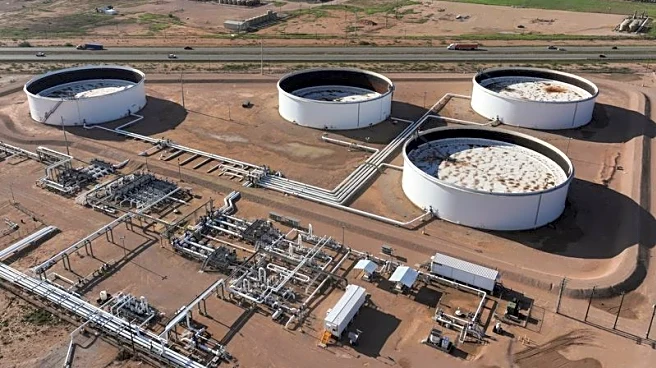What's Happening?
The U.S. Energy Information Administration (EIA) has reported a rise in crude oil inventories by 3.0 million barrels for the week ending August 8, reversing a previous decline of 3 million barrels. This increase brings the total commercial stockpiles to 426.7 million barrels, which is 6% below the five-year average for this period. The report follows data from the American Petroleum Institute (API) indicating a smaller inventory growth of 1.5 million barrels. The announcement has influenced crude oil prices, with Brent trading at $66.06 per barrel, marking a $2.70 per barrel decrease from the previous week. Similarly, West Texas Intermediate (WTI) saw a decline of $0.14 per barrel. The EIA also noted changes in other petroleum products, with motor gasoline inventories decreasing by 800,000 barrels and middle distillates increasing by 700,000 barrels.
Why It's Important?
The increase in crude oil inventories can have significant implications for the U.S. energy market and broader economy. Higher stockpiles may lead to lower oil prices, affecting profitability for oil producers and potentially reducing costs for consumers. This development is crucial for industries reliant on petroleum products, such as transportation and manufacturing, as it may influence operational costs and pricing strategies. Additionally, fluctuations in oil prices can impact inflation rates and economic growth, making inventory levels a key indicator for policymakers and investors. The data also highlights the ongoing dynamics in the global oil market, where supply and demand factors continuously shape price movements.
What's Next?
Market participants will likely monitor upcoming EIA reports and other industry data to assess future inventory trends and their impact on oil prices. Analysts may also consider geopolitical factors, such as production decisions by OPEC and other major oil-producing countries, which could influence supply levels. Companies in the energy sector might adjust their production strategies in response to inventory changes, aiming to optimize profitability amid fluctuating prices. Furthermore, policymakers may evaluate the economic implications of inventory shifts, considering potential measures to stabilize the market and support economic growth.












